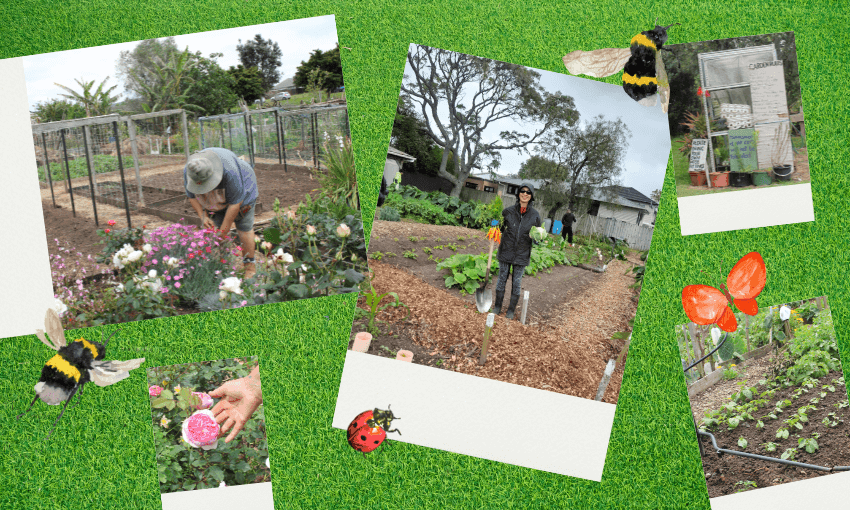From Middlemore to Papatoetoe, seven teaching gardens are empowering communities to produce their own food. Here’s how.
On Monday, Wednesday, Friday and Saturday mornings, a stream of people drag wheeled shoppings bags past the historic school house on the corner of Kirkbride Road and Naylors Drive in Māngere. They continue down the winding gravel drive towards a thicket of native trees intermixed with bananas. Past the trees and over the creek, the gravel leads to a battalion of bamboo poles and repurposed wooden planks. There’s order here – they’re splitting the land into 50-odd plots, each two metres by five metres, tended by a different person or whānau. Green shoots spring up from everywhere; the soil is dark and rich.
While the plots are busy, they’re only part of the three-acre Old School Teaching Garden. There are also bigger shared plots, a fledgling food forest and a flock of little Indian Game Chickens scratching around. In the centre of it all is a big open shed, and there, Yvonne Thomas, the legendary 81-year-old who’s been teaching here for almost 16 years.
“It’s such a great cross-pollination of people,” she says. “We’ve got all sorts.” The oldest gardener is “about 90” and the youngest are toddlers brought in by their parents or grandparents. Thomas says at any time there’s up to 14 different nationalities in the garden. Groups of people sentenced to community service or periodic detention are also regular visitors, a welcome source of muscle. This week they planted out kumara slips and silverbeet; last week it was lettuce plants and mulching the potatoes with pea straw. On other days groups of school children or pre-schoolers will come to visit.
While among the adults there’s some experienced gardeners, what amazes Yvonne is that “people just do not know where their food comes from, or how they get the seeds, or all the rest of it.”
For many people living in Tāmaki Makaurau, growing food is a lost skill. The Old School Teaching Garden is just one of seven teaching gardens in South Auckland which help their local community regain those skills. The gardens are run by the Auckland Teaching Gardens Trust, a charity seeded in 2008 that receives funding from the Auckland Council and the Ōtara-Papatoetoe, Māngere-Ōtāhuhu and Manurewa local boards, which also provide the land on which the gardens are established. In these gardens, food is being grown and those new to gardening are being mentored by old hands. Fresh veges are especially pertinent here, as South Auckland contains many economically deprived neighbourhoods saturated with unhealthy takeaway joints. The gardens are here to interject, to break the cycle. They show those who participate, or who visit, that a small patch of garden, or even a collection of recycled buckets, can grow food.
The cornerstone of the Teaching Gardens’ approach are the plots. These are assigned to local families or individuals on six month seasonal rotations, for a cost of $30. They’re hot property – all are usually full and there are waiting lists for each garden. Donna Hansen, the trust’s chair, or “glue that holds it all together,” says she gets multiple emails every week from people wanting a plot. Once they’re in, the mentors encourage them to take their learning home, so that others can come through.
“They don’t want to leave,” says Jane, who has mentored at the Maich Teaching Garden in Manurewa for the past eight years. “Everybody wants to stay there forever.” Jane has been gardening since she was a “skinny, tiny” six-year-old in Vietnam. The water in the rice paddies would come up to her chest – “can you imagine?” She laughs. Jane keeps the Maich garden tidy. Whereas in the Old School garden every nook and cranny is jammed with containers, bits of wood, and stacked up chairs that might come in handy one day, at Maich the paths and corners are clear. Everything has its place in one of the two shipping containers under the neat corrugated iron roof.
The people looking after the plots here range from 21 to 84 years old. Some already know basic gardening, and others are trying it for the first time. When the garden is open on Wednesdays and Saturdays, Jane makes her way around the plots to help, and to give people hands-on guidance. Every plot is unique: there are different styles of growing, and different plants. The many migrant gardeners here love to grow vegetables from their home countries where possible, says Jane. The most common questions she is asked are “is this a weed or vegetable?” and if it’s a vegetable, “how can I take care of this?” The slightly more experienced gardeners are interested in ways to prevent plant diseases and alternatives to insecticides.
A similar approach is taken by Denise at the Middlemore Teaching Garden in Papatoetoe. “Everyone wants to have a discussion on what’s going on in their garden,” she says. From a slit cut in the crown of her Bunnings bucket hat, a bun of grey hair spills out. “For me, that’s teaching. I don’t think it’s sitting in a classroom. I prefer individual conversation.” Denise was a teacher for many years, and is the kind of person who will gift you a jar of homemade pickle jam, and also invite you to dig a hole for planting the lemon tree. Some of those who take her up on the offer in exchange for a bag of vegetables enjoy it so much they return and ask for their own plot.
The Middlemore Teaching Garden is tucked into the gently sloping southern bank of Middlemore Park, just 800 metres from the hospital. There’s plenty of parking and a playground right in front. Beside the entrance, a mountain of woodchip and mulch has been dropped off by arborists and will soon make its way into compost bins and vege beds. The 60 plots, each five metres by five metres, form a grid in the centre of the space. On the edges are shared spaces where people can help if they don’t get their own plot for the season. There’s a small grove of oranges, hundreds of kūmara slips in small dirt mounds, bananas bearing almost-ready fruit, a bed of taro, and a children’s corner lush with feijoa trees where visiting school groups pot out seeds.
Denise is not the only teacher here. In assigning the plots at Middlemore each season, she makes sure to place experienced gardeners beside brand new ones so they can share knowledge. “It’s nice, it’s really lovely,” she says. The range of gardeners is diverse, coming from different backgrounds, religions and places in their lives. “I’m really happy that we have no arguments,” she says. Like the rest of the teaching gardens, there’s really only one rule here: no stealing.
We walk through the labyrinth of plots, and she points out those which are “first gardens”. One belongs to a young single mum who comes with “the wee baby on her hip”. On its edge, four softly furry tomato seedlings grow from huge white repurposed buckets. Denise has been introducing “bucket gardens” to show people that “you don’t need a whole garden”. It’s a method of gardening that’s been seeing more interest across all the teaching gardens as more and more medium density townhouses crop up in South Auckland. Denise points to a line of them just over the fence. They have balconies, but they’re small, and the ground level is almost entirely covered in concrete. A perfect opportunity for container gardening. Denise has also found that people who rent their homes are interested in learning how to grow things in pots, so they can take them along when they move.
Further in, a carefully organised plot has not a single weed. Its soil is moist and dark. This too is a first garden, belonging to a young guy who has “many garden uncles telling him what to do”. Like many of the younger gardeners, he works full time, so struggles to get to the gardens during their standard opening hours. Denise now opens an additional session, on Wednesday evenings from five to seven. “The evenings are beautiful in the summer, it’s just so pretty.” The gardeners tend to come straight after work, and “often there’s 20 bucks of fish and chips or something to share”. Another young first gardener, his plot bursting with greens, “comes in and he just sits in the middle and smiles”.
The gardens have an impact beyond the people who step inside. Many of the beds around the edge of the Middlemore garden have wooden signs which say “Food Bank”. Just this morning, Denise has sent three boxes of silverbeet, two boxes of lettuce and half a box of rhubarb and lemons to the local food bank. Every Wednesday she sends more.
The Maich garden also produces more food than the gardeners can eat. Jane makes an effort to donate it to the local community. She will deliver it to elderly people, stock up the community pantry and take full boxes to churches where people can help themselves. “Vegetables everywhere,” she says. Vegetables from the Old School Garden make their way to Mr T’s community bike centre behind Māngere town centre, a network of marae, the women’s refuge, local schools and “small lots I’ll put in the pātaka on the way home”, says Yvonne.
As much as the gardens give out, they also take in. Yvonne, Donna and I crunch through the paths at the Old School garden. They’re layered with mussel shells, given by a mussel fritter stand at the markets. The big white canvas bags the shells arrive in are being toted around, now filled with horse manure, woodchip, coffee grounds or sometimes pigeon droppings and feathers. “We recycle all sorts of things,” says Yvonne. “As I say to people, we do everything that’s free because we’ve got no money.”
Among the jumble of things to reuse in the open shed, Yvonne shows me a photo taken in 2009, when the garden was first being developed. A group of smiling people are gathered on the left, and she’s there smack-bang front and centre. Behind them, large areas of flat dirt have been cleared of grass. “When I first came here, there wasn’t a tree in sight,” she says. It’s unrecognisable today – you’d be hard pressed to find a millimetre of grass or unused earth. But perhaps the biggest change isn’t here in the garden, but in the South Auckland community it serves. “Families are realising more and more that it’s far better to grow their own stuff.”

